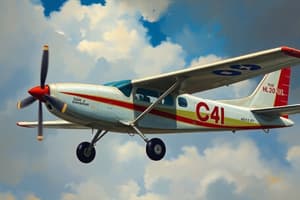Podcast
Questions and Answers
What is the primary role of the Civil Aviation Safety Authority (CASA)?
What is the primary role of the Civil Aviation Safety Authority (CASA)?
- To conduct the safety regulation of civil air operations (correct)
- To issue driver's licenses
- To oversee the construction of roads and highways
CASA is a privately-owned and operated organization.
CASA is a privately-owned and operated organization.
False (B)
What does "AMO" stand for?
What does "AMO" stand for?
Approved Maintenance Organization
Which of these is NOT a requirement for an AMO to have?
Which of these is NOT a requirement for an AMO to have?
What is the main purpose of a "Certificate of Release to Service" (CRS)?
What is the main purpose of a "Certificate of Release to Service" (CRS)?
What does a "Special Flight Permit" (SFP) authorize?
What does a "Special Flight Permit" (SFP) authorize?
A Type Certificate (TC) is required for all types of aircraft.
A Type Certificate (TC) is required for all types of aircraft.
What is NOT a characteristic of "Restricted Category" aircraft?
What is NOT a characteristic of "Restricted Category" aircraft?
An AMO must have a _______ that details its procedures for carrying out maintenance.
An AMO must have a _______ that details its procedures for carrying out maintenance.
The "Minimum Equipment List" (MEL) is a document that only applies to large transport category aircraft.
The "Minimum Equipment List" (MEL) is a document that only applies to large transport category aircraft.
What is the primary function of a "Service Bulletin" (SB)?
What is the primary function of a "Service Bulletin" (SB)?
How are "Airworthiness Bulletins" (AWBs) different from "Airworthiness Directives" (ADs)?
How are "Airworthiness Bulletins" (AWBs) different from "Airworthiness Directives" (ADs)?
What is the primary goal of an "Extended Diversion Time Operation" (EDTO) Reliability Program?
What is the primary goal of an "Extended Diversion Time Operation" (EDTO) Reliability Program?
All-Weather Operations (AWO) are only applicable to aircraft equipped with an Instrument Landing System (ILS).
All-Weather Operations (AWO) are only applicable to aircraft equipped with an Instrument Landing System (ILS).
What does "DH" stand for in the context of low-visibility operations?
What does "DH" stand for in the context of low-visibility operations?
Category III operations in low-visibility conditions require an automatic landing system.
Category III operations in low-visibility conditions require an automatic landing system.
The "Aircraft Maintenance Planning Document" (MPD) is only required for aircraft operating under a Regular Public Transport (RPT) Air Operator’s Certificate.
The "Aircraft Maintenance Planning Document" (MPD) is only required for aircraft operating under a Regular Public Transport (RPT) Air Operator’s Certificate.
What is the main purpose of "Continuing Airworthiness" requirements?
What is the main purpose of "Continuing Airworthiness" requirements?
A "Certificate of Compliance" (COA) is only required for an AMO that performs maintenance for a Regular Public Transport (RPT) aircraft.
A "Certificate of Compliance" (COA) is only required for an AMO that performs maintenance for a Regular Public Transport (RPT) aircraft.
Match the following categories of aircraft engineer licenses with their typical responsibilities.
Match the following categories of aircraft engineer licenses with their typical responsibilities.
Flashcards
Category A Licence
Category A Licence
A licence allowing maintenance certification for small aircraft tasks.
Category B1 Licence
Category B1 Licence
A licence for structural, mechanical and electrical systems maintenance certification.
Category B2 Licence
Category B2 Licence
A licence for avionics and electrical systems maintenance certification.
Category C Licence
Category C Licence
Signup and view all the flashcards
Civil Aviation Act 1988
Civil Aviation Act 1988
Signup and view all the flashcards
AIS (Air Navigation Act)
AIS (Air Navigation Act)
Signup and view all the flashcards
ICAO
ICAO
Signup and view all the flashcards
CASR
CASR
Signup and view all the flashcards
Aircraft Engineer Licence
Aircraft Engineer Licence
Signup and view all the flashcards
Maintenance Certification
Maintenance Certification
Signup and view all the flashcards
Simple Test
Simple Test
Signup and view all the flashcards
Type Rating
Type Rating
Signup and view all the flashcards
PICAO
PICAO
Signup and view all the flashcards
Type Certificates
Type Certificates
Signup and view all the flashcards
Approved Maintenance Organisation (AMO)
Approved Maintenance Organisation (AMO)
Signup and view all the flashcards
Base Maintenance
Base Maintenance
Signup and view all the flashcards
Line Maintenance
Line Maintenance
Signup and view all the flashcards
Bilateral Aviation Safety Agreement
Bilateral Aviation Safety Agreement
Signup and view all the flashcards
CASA
CASA
Signup and view all the flashcards
Regulatory Framework
Regulatory Framework
Signup and view all the flashcards
Safety Management Systems (SMS)
Safety Management Systems (SMS)
Signup and view all the flashcards
Air Operator's Certificate (AOC)
Air Operator's Certificate (AOC)
Signup and view all the flashcards
Guidance Material
Guidance Material
Signup and view all the flashcards
Continuation Training
Continuation Training
Signup and view all the flashcards
Advisory Circulars (ACs)
Advisory Circulars (ACs)
Signup and view all the flashcards
Civil Aviation Orders (CAOs)
Civil Aviation Orders (CAOs)
Signup and view all the flashcards
Manual of Standards (MOS)
Manual of Standards (MOS)
Signup and view all the flashcards
Mutual Recognition Agreement
Mutual Recognition Agreement
Signup and view all the flashcards
Provisional Type Certificate
Provisional Type Certificate
Signup and view all the flashcards
Special Certificate of Airworthiness
Special Certificate of Airworthiness
Signup and view all the flashcards
Aircraft Classifications
Aircraft Classifications
Signup and view all the flashcards
Study Notes
CASA B-10c Aviation Legislation
- This module covers aviation legislation within the context of a Category B Licence.
- Copyright 2020 Aviation Australia; all rights reserved.
- No part of the document may be reproduced, transferred, sold or disposed of without written permission from Aviation Australia.
- This is a controlled document for CASA Part 66 training materials only.
Knowledge Levels
- Basic knowledge for categories A, B1, B2, and C aircraft maintenance licences is indicated by knowledge levels (1, 2, or 3).
- Category C applicants must meet the basic knowledge levels of B1 or B2.
- The knowledge levels are defined as follows:
Level 1
- Applicants are familiar with the basic elements of the subject and can give a simple description of it, utilising common words and examples.
- Applicants can also use typical terms.
Level 2
- Applicants have a general knowledge of the theoretical and practical aspects of the subject and can apply this knowledge.
- Typical examples and mathematical formulae are used to describe the subject.
- Sketches, drawings, and schematics are used to illustrate the subject.
- Practical procedures are used in applying knowledge.
Level 3
- Applicants have a detailed knowledge of the theoretical and practical aspects and demonstrate the ability to logically combine and apply separate elements of knowledge in a comprehensive manner.
- Detailed descriptions of the subject utilising theoretical fundamentals and specific examples are provided.
- Complex mathematical formulae, drawings and schematics are included.
- Manufacturer's instructions are included to apply knowledge in practical practice.
- The ability to interpret results using various sources and measurements and apply corrective actions where necessary is demonstrated.
Studying That Suits You
Use AI to generate personalized quizzes and flashcards to suit your learning preferences.
Related Documents
Description
Test your knowledge of aviation legislation relevant to a Category B Licence. This quiz covers essential concepts, knowledge levels, and requirements for various aircraft maintenance licences. Aimed at those in CASA Part 66 training, it helps reinforce crucial legislative understanding.




